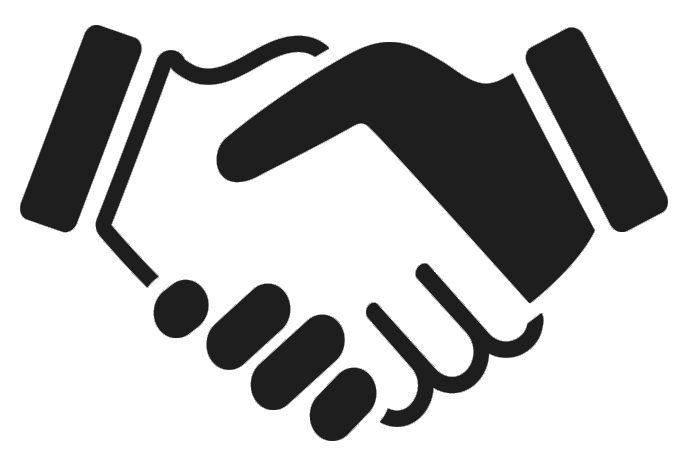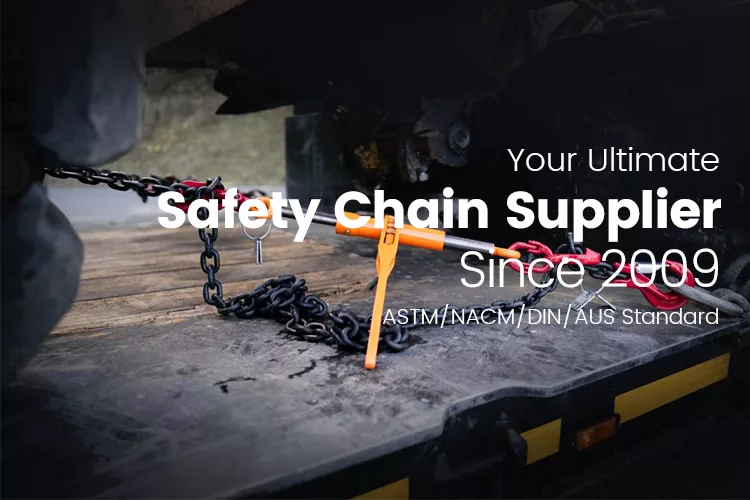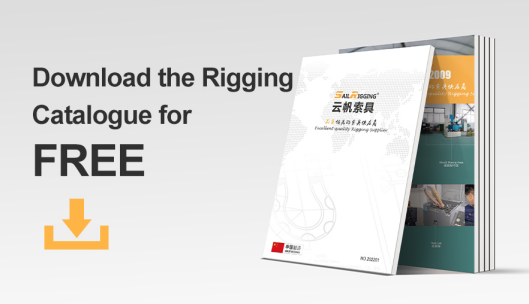3 Types of Trailer Safety Chain and How To Hook Up Safety Chains On A Trailer
Safety chains are the chains that connect the trailer’s drawbar to the towing vehicle and are an important part of ensuring the trailer is properly connected to the towing vehicle. Although safety chains may seem insignificant, they are actually an extremely important part of the trailer and are essential to ensure the safe operation of the trailer. When driving, in the event of a hitch failure of the ball joint or coupler, the safety chains also ensure that the trailer is safely guided and controlled to a safe stopping point.
Table of Contents

Requirements For Safety Chains For Trailers
Safety chains should consist of two parts, a chain and a hook (S hook, clevis hook, eye hook, slip hook, etc.), each of which is equipped with a hook or other device for connecting to the towing vehicle; a single safety chain extending from two connection points on the towed vehicle along both sides of the tow bar and forming a system with a single connection device.
Why Need to Use Safety Chains?
Safety chains are used in many situations, such as many American families own boats or camping trailers for vacation. Safety is of paramount importance when a vehicle is towing a boat or camper. Braking is more difficult and dangerous when towing a trailer. The greater the weight to be towed, the greater the inertia, especially at high speeds, and it takes a longer distance to stop the vehicle. Therefore, most states require the use of trailer safety chains when the trailer exceeds a certain weight limit and reaches the maximum towing speed (as low as 25 miles per hour).
The Quantity Of Safety Chains On A Trailer
Although one safety chain is sufficient in most cases, it is recommended that you use two safety chains every time you tow a trailer. In this case, the safety chain is attached to the trailer frame and the hitch of the towing vehicle, providing an additional layer of safety in the event that the primary hitch fails or disconnects while driving.
Using a single or dual safety chain is a matter of personal preference, and it is up to the tow truck driver to decide which option is best for them. But it is important to remember that safety is always the primary consideration when hauling any type of cargo on the road.
How to Check Trailer Chains?
In Montana, USA, 80% of wildfires are caused by humans. Trailer and towing chains are a major cause. Loose chains can drag along the road surface, creating sparks and starting roadside fires. Precautions taken before driving on highways and roads can prevent wildfires when towing.
- Securely connect the trailer chains, crossing the chains in an X shape.
- Position the safety hooks toward the vehicle and away from the trailer.
- Keep some clearance between the trailer chains and the road surface. If the trailer is still touching the road, or there is not enough clearance between the chain and the road, just twist the chain a few times to take up the slack.
How To Hook Up Safety Chains On A Trailer Properly?
Safety chains are an important part of the truck and trailer combination, and in most states, they are required by law on all but the fifth wheel. For safety chains, how to install them properly is especially important for trailer safety.
- Check your chain to make sure the links are intact and that nothing is loose or damaged.
- Carefully inspect the safety hooks, clevis hooks, eye hooks, slide hooks, grab hooks, S hooks, etc.
- Look at where the safety chain is connected to the trailer’s drawbar (sometimes it is bolted and sometimes welded to the trailer’s drawbar) Check for cracks or damage at that weld.
- After checking the chain, if everything is OK, connect the chain to the hook. We will cross the connection in an X shape, and we cannot cross the chain to the top of the trailer’s drawbar, otherwise it may get stuck between the ball and the coupler. You should cross the chain under the trailer hitch. We will connect the chain on the passenger side of the trailer to the driver side and vice versa.
- Keep the chain of the appropriate length, usually 3 to 5 inches long, if the chain is too long, twist the chain up a few times to take up the slack and pull it off the ground.
- Every time you connect the chain, make sure the safety hook is pointed towards the trailer. This reduces the possibility of the safety chain falling off if the ball falls off the coupler, and prevents the trailer tongue from falling off.
3 Types Of Trailer Safety Chain Assemblies
There are many types of chains with different safety hooks, ranging from G30 to G70. The hooks include horn sliding hooks, horn grab hooks, S-shaped hooks, eye-shaped grab hooks, eye-shaped sliding hooks, etc. Of course, there are also single-end hooks, and the other end is matched with chains. Here we introduce several common safety chain combinations.
G30 chain with S Hooks At Both Ends
The chain implementation standard is ASTM 80/ NACM90/ NACM96, chain grade G30, and the S-shaped hooks are all electroplated with white zinc. The common sizes are 3/16 1/4 5/16, and different lengths can be provided, such as 27 inches, 35 inches and 48 inches, with a minimum breaking force from 3200-8000lbs.

G43 Chain With Slip Hooks At Both Ends
The chain is made according to ASTM 80/ NACM 90/ NACM 96, the hook is an American horn hook, the chain and safety hook are G43, the surface is usually electroplated with white zinc, or yellow zinc, the processing technology is welding, the common sizes are 1/4, 5/16, 3/8, 1/2, 14 inches, 16 inches, 18 inches, 20 inches, 25 inches, 30 inches are available, the minimum breaking force is from 7500-27600lbs.

G70 Chain With Clevis Grab Hooks At Both Ends
The chain is implemented according to ASTM 80/ NACM 90/ NACM 96, and the hook is an American claw hook. The chain and safety hook are rated G70. The surface is usually electroplated with yellow zinc, and the processing technology is welding. The common sizes are 1/4, 5/16, 3/8, and 1/2. It can provide 14 inches, 16 inches, 20 inches, 25 inches, and 30 inches. The minimum breaking force ranges from 12600-45200lbs.

Conclusion
Safety chains are crucial for road safety transportation. Knowing more about safety chains as much as possible will help you choose a more suitable safety chain, and choosing the right model will be more effective. If you want to know more useful information, you can write or email Sail Rigging for consultation.





